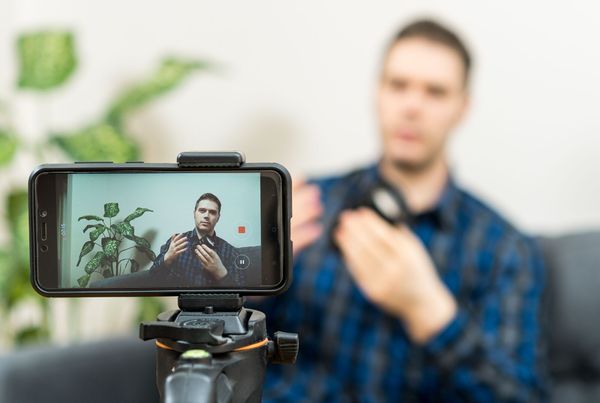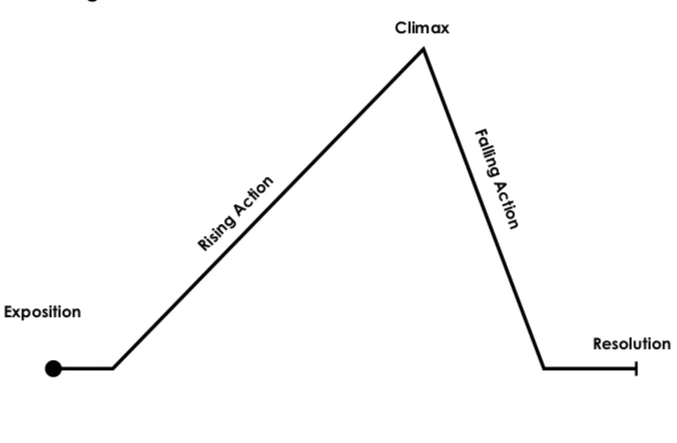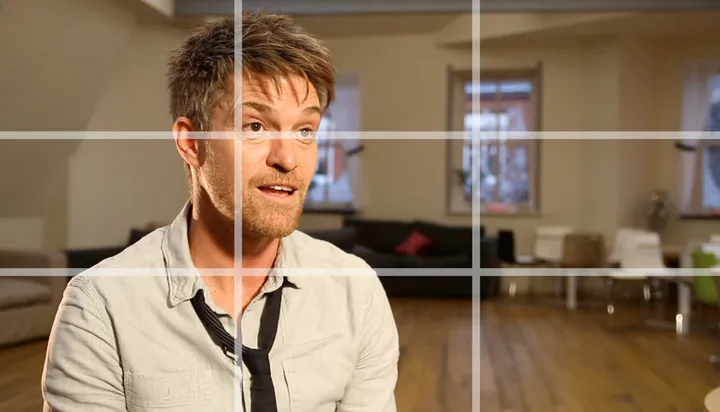Talking head interviews provide the perfect platform for company CEOs and employees to communicate with each other and to boost communication company-wide. Content and Social Media Managers love video interviews... promoting a company online to customers, partners and online communities with engaging video content has never been so easy!
These interviews give audiences an inside look at companies and the people who work there — with a personal, human touch that makes them primed for sharing online. In fact, internet users are twice as likely to share video content than any other type of content.
Check out the Video Interview Guide to get familiar with some of the basics. Here, you're going to discover 5 tips for taking your talking head interviews to the next level.
Are you ready? Let's get talking!
The magic of a talking head interview
A talking head interview is, of course, not a magically floating head speaking words of wisdom like a genie just arisen from its lamp. These types of interviews, however, do work like magic for a huge variety of use cases in marketing, internal and external comms, community management, human resources, recruitment, to name but a few.
The superior storytelling you can achieve through the video format makes these interviews highly engaging for audiences. Here are a few stats to whet your appetite:
- Wyzowl's 2020 Video Marketing Report states that 96% of people have watched an explainer video to learn more about a product or service
- RecRight has found that recruiting agencies report 800% more engagement with job postings that have video embedded.
- Sprout Social discovered that 70% of consumers feel more connected to brands with CEOs that are active on social.
Whether you're a marketer who wants to create an explainer video for a new product, an HR manager who wants to attract the best talent with a video job posting, or you're even a company CEO who wants to connect with online communities on social media — video interviews can boost engagement for your communications and give them that vital human touch.
The idea of a talking head interview is incredibly simple — it's just someone answering questions and speaking toward a camera or interviewer, right? But to maximize the overall production and entertainment value of the final video, there are a few magic tricks worth having up your sleeve.
Before getting into the specifics, let's go over some of the main ways you can use your talking head interview.
Discover the power of PlayPlay's recruitment video maker and effortlessly create professional videos that captivate audiences. Say goodbye to endless editing and hello to impactful visuals that leave a lasting impression.
I wish my talking head interview could be...
Here is a quick overview of the main types of talking head interviews you can create. For a more in-depth exploration of these use cases, check out the Video Interview Guide.
- Employee interview: Whether you want to show off your cool company culture, build a strong sense of community between employees, keep everyone up to date about your latest projects, or recruit your next superstar — employee interviews are hot content to keep your workforce connected internally and to promote your company brand externally!
- Thought leadership interview: Want to show that your company is leading the way in the field and propelling the industry toward new heights? Getting a company CEO or senior employees on camera to discuss industry topics, recent achievements, future projects or key insights can help your company to become a trusted authority in the industry.
- Expert interview: A talking head interview with industry experts is perfect for promoting your brand, winning the trust of new customers and providing them with high-quality, informative content. Interviews with experts not only ensure the credibility of your message, but could also help you reach out to new audiences through the 'fame factor' that associates your brand with notable people.
- Customer interview: Interviews with customers bring credibility and authenticity to your company's pitch, while also publicly valuing the feedback of your customers. These interviews can help you to provide answers to any questions that prospective customers may be having before they purchase your company's product/services.
Top 5 tips for acing a talking head interview
1. Create a script that tells a story
No matter how you intend to use your talking head interview, your aim is to communicate a clear message about a given subject. One of the most engaging ways to communicate this message is through storytelling, and this requires a script in order to achieve the best results.
This storytelling can be represented through a standard 'story arc' diagram, which will help you to organize the final message of your talking head interview.
This structure can be used as a basic template for a variety of videos, including customer testimonials and success stories, company mission statements, project recaps, announcements, explainers... you will just need to adjust the content accordingly.
Here is a general example:
- Exposition: Introduce the interviewee and the topic of the interview
- Rising Action: Discuss the situation that the interviewee faced in relation to the topic: what were their objectives or intentions? How were they feeling about it? Use this 'rising action' to create interest for the audience — personal experiences involving emotion can be a great hook
- Climax: Announce the solution to these issues — that 'Aha' moment where the hero, which would be your brand in most cases, arrives on the scene to save the day and makes sure that these objectives are reached
- Resolution: Drive home the final message or call-to-action for the audience
Of course, no one size fits all, but this template can be a useful guide for creating an interview script that will deliver your message effectively in your video.
It is also worth taking some notes throughout the interview in case there is a particular topic you want to come back to or clarify after the first take... This way, you can guarantee that you cover every discussion point before the interviewee leaves!
2. Use multiple cameras for filming
Using more than one camera to film your talking head interview is a great way to make your final video more engaging for the viewer. First, let's quickly go over the two main filming styles:
To-camera
- Shows the interviewee looking directly into the camera, as though they are speaking to the audience directly
- Best for giving direct messages, such as announcements from a company CEO, explainer interviews, company mission interviews or recruitment interviews
- Autocue can easily be used to help the interviewee deliver the speech
- Use a clean and striking video interview background to make it memorable for your viewers.
Off-camera
- Shows the interviewee looking just to the side of the camera, as though they are speaking to a real person in the room.
- Make sure you have a clear video interview background.
- Gives a more traditional, documentary style to the video, and can be helpful for interviewees who are less experienced on camera
- This style provides a more spontaneous, conversational effect and is best for customer testimonials, expert interviews and employee interviews
Both filming styles can certainly be used for each of the different use cases. It's just worth thinking about the overall 'feel' you want final your video to have.
Whichever you choose as your main recording style for the majority of the video, you could try using an additional camera to record from a different angle. This will help you during the editing process to create a dynamic video with a variety of shots that will keep audiences more engaged.
If your main filming style is 'to-camera', place the second camera at a 45° angle to the interviewee. If you want to get creative, you could also experiment with a close-up shot using the second camera, so that you have a variety of depths in your footage. Whether you decide to use one camera or two, make sure that they are placed at eye-level with the interviewee.
3. Respect the rule of thirds
If you have chosen a 'to-camera' filming style, then you should position your interviewee in the center of the shot, giving focus to the shoulders and head. However, if you decide to go for an 'off-camera' style, then you should take into account the rule of thirds.
The rule of thirds is designed to help you achieve the most aesthetically pleasing shot composition. It is a grid of 4 intersecting lines that creates a grid of 9 parts.
Photo credit: videoknowhow
The idea is that you position the interviewee at one of these intersections, depending on which way they are facing.
If your interviewee is looking across the frame from left to right, position the center of your subject's body on the left third. Position their eyes on the top third. Viewers naturally look toward these sections on an image or video, so these lines will help you to ensure that the interviewee is the focal point.
This technique will also ensure that your shot composition gives the interviewee enough headroom (space above their head) and enough lead room (the space in front of them, where they are looking). Ensure that your interviewee is facing in the direction where the most space is in front of them.
In fact, most smartphones have the option to turn on gridlines for filming a video, so you can still achieve great-looking shots without the need for specialist equipment!
4. Get the best out of natural lighting
If you don't have any lighting equipment available, follow these steps to ensure that you can make the most of the natural light (including office lighting) that is available on set. If you can get your hands on some lighting kit, check out our lighting guide (insert link) for more info.
- If you are filming inside, be really selective about the spot you choose and explore the building you are in. Is there a particularly well-lit area you can take advantage of? if possible, it's best to film around late morning/early afternoon, when the natural light will be most consistent. Whereas, it could change quite rapidly towards the end of the day.
- If the room you're filming in has windows, use this lighting to your advantage. Have your interviewee face toward the window, but don't position them too close to it. In an ideal world, it will be a cloudy day. But if the sun is shining through, keep your interviewee out of the direct sunlight.
- Think about the lighting balance. The window acts as a 'key light' — the main light on your subject. The ambient lighting in the room acts as your 'fill light'. When balanced correctly, the key light will highlight your subject’s features. The fill light adds detail and dimension by countering the shadows created by the key light.
- Tweak your setup to achieve the correct balance between the 'key light' and 'fill light'. This might involve testing several positions for the interviewee at different distances from the window until you find the right balance.
5. Use on-screen text and B-roll footage
Again, storytelling is essential to a high-quality, engaging video. On-screen text and B-roll footage will not only create a more entertaining experience for the viewer, they will also help drive home the key message of your video.
On screen text
- frames the interview video questions and can be used to transition between topics
- highlights the key points that the interviewee makes and emphasizes the key messages of the overall interview
Transition screens that feature on-screen text are great for structuring your video and to present the interview questions — especially in a talking head video where there isn't an interviewer on camera.
- adds visual interest and context to a video
- can be used for the video intro and outro and helps to set the scene for the interview
- helps you to edit out unwanted moments in the interview (coughing, sneezing, fidgeting...) without making the edits seem obvious to the viewer
To capture great b-roll footage, film the interviewee in their work environment. Depending on the interviewee's profession, this could be as simple as sitting at their desk, typing on their computer, or preparing for a meeting in a conference room.
Talk to the interviewee about their daily work routine, and simply film them performing one of these tasks — just make sure that it's relevant to the message of the video!
You can also include brief shots of the building, street signs, inside the office space — anything that will help you to set the scene and add visual interest to the interview.
Where the real magic happens...
And voila! 5 top tips for acing your next talking head interview. These simple production techniques could work like magic for your team and help you to create a more engaging video experience for your audience.
Here's a quick recap of the key takeaways:
- Create a script
- Use multiple cameras
- Respect the rule of thirds
- Get the best out of natural lighting
- Use on-screen text and B-roll footage
But here's a little bonus tip, just for you...
Why not try out PlayPlay's 7-day free trial for your next talking head interview?
PlayPlay's video creation tool enables comms, marketing and social media teams to produce high-quality videos in minutes, without the need for editing skills. If you're looking to create your own video interviews quickly, easily and regularly — without any expensive production costs — PlayPlay could be the perfect tool for you.
Louise Antonas
Head of Recrutment
With 12 years' experience in recruitment for major French groups. At PlayPlay, Louise is responsible for a team of 5 people, covering an international scope to recruit from our offices in Paris, New York and Berlin.






